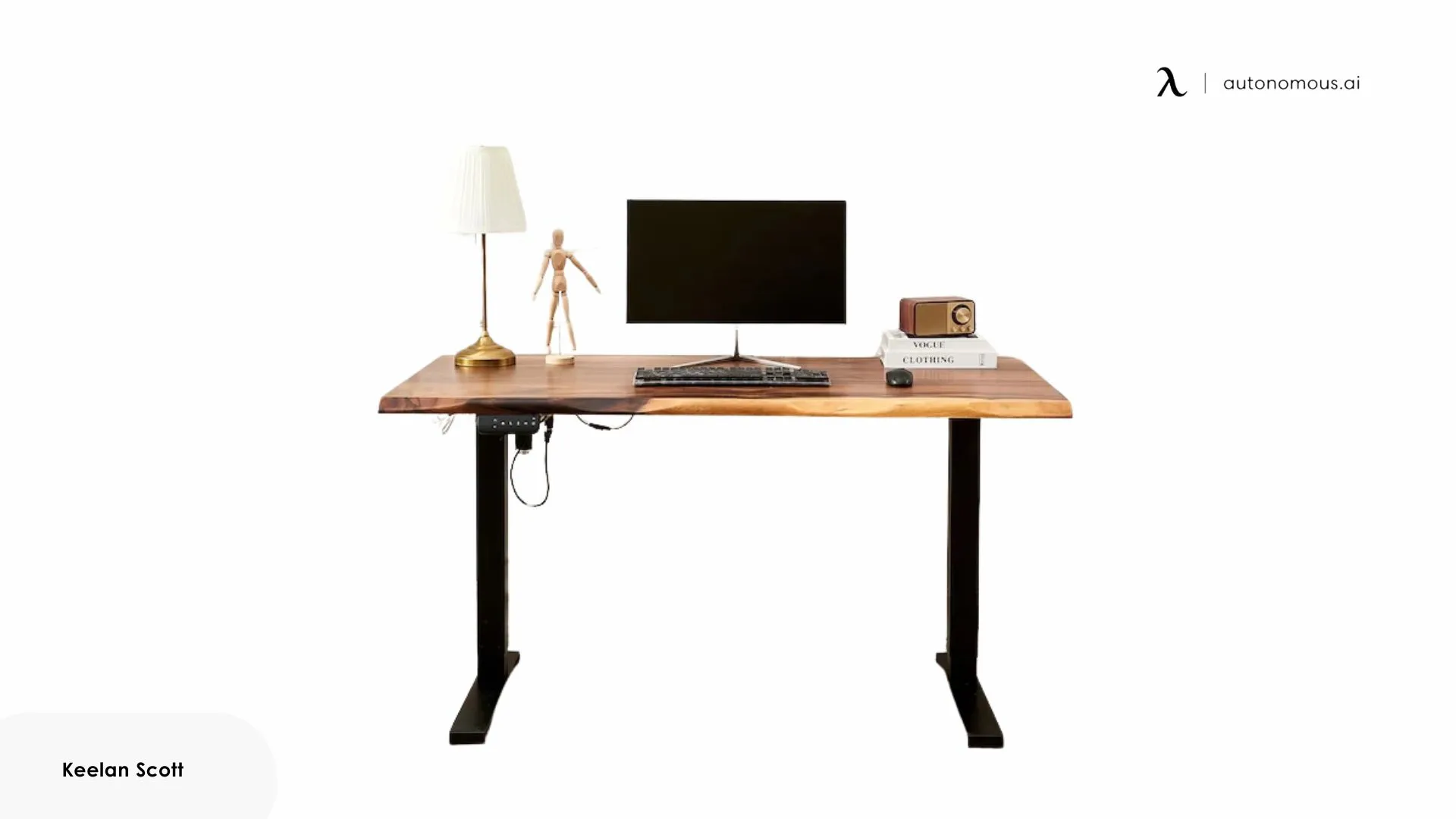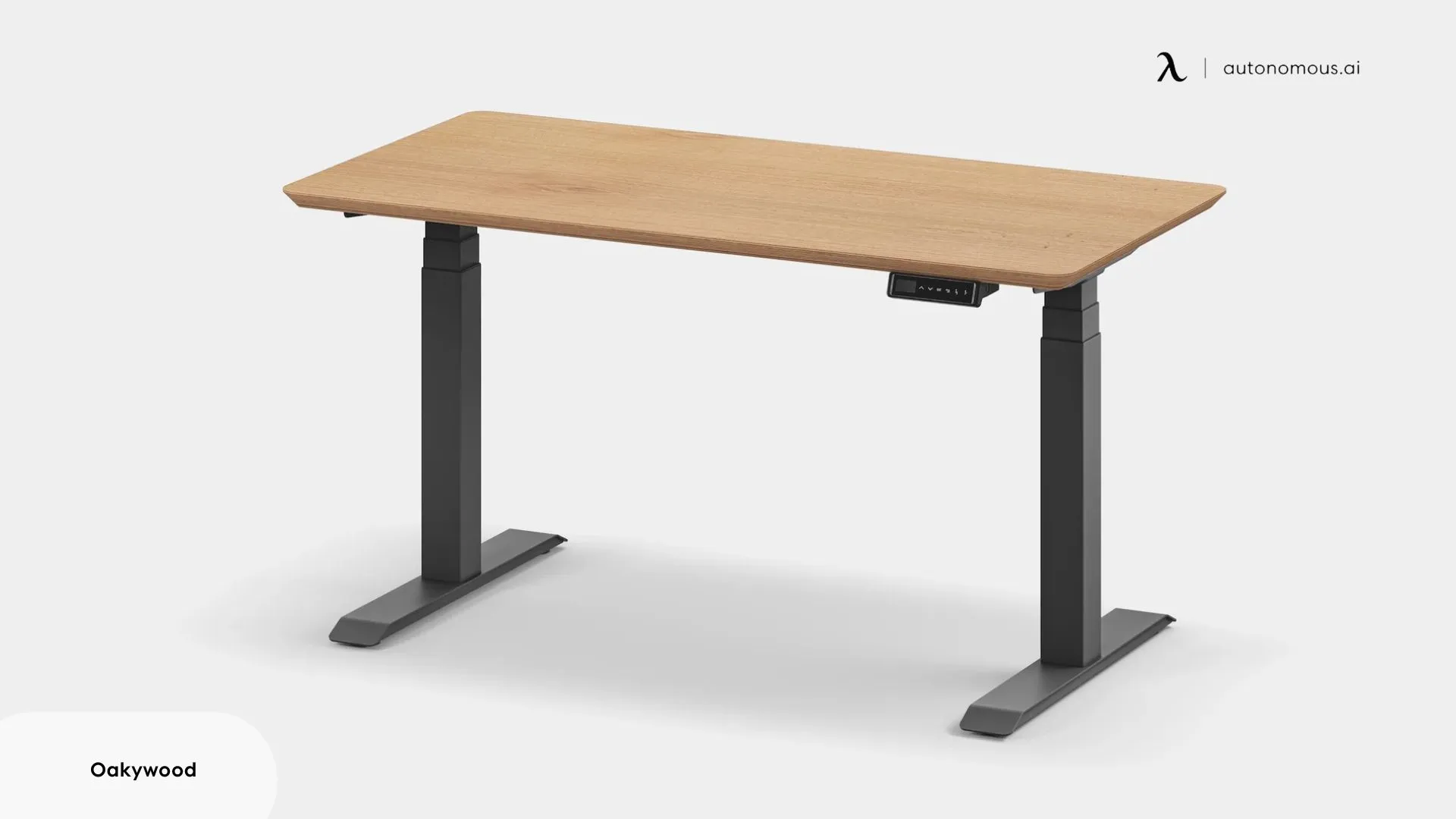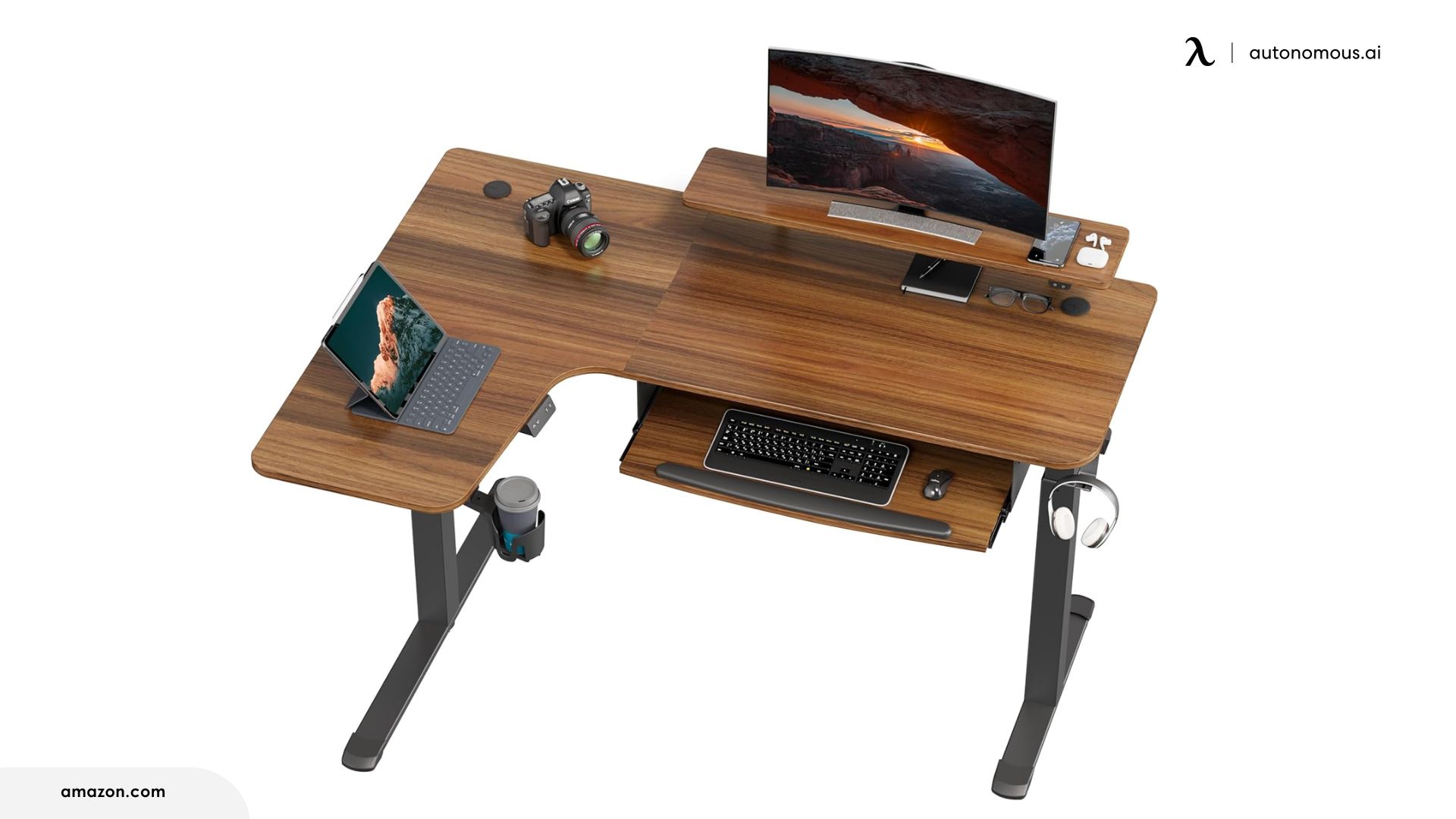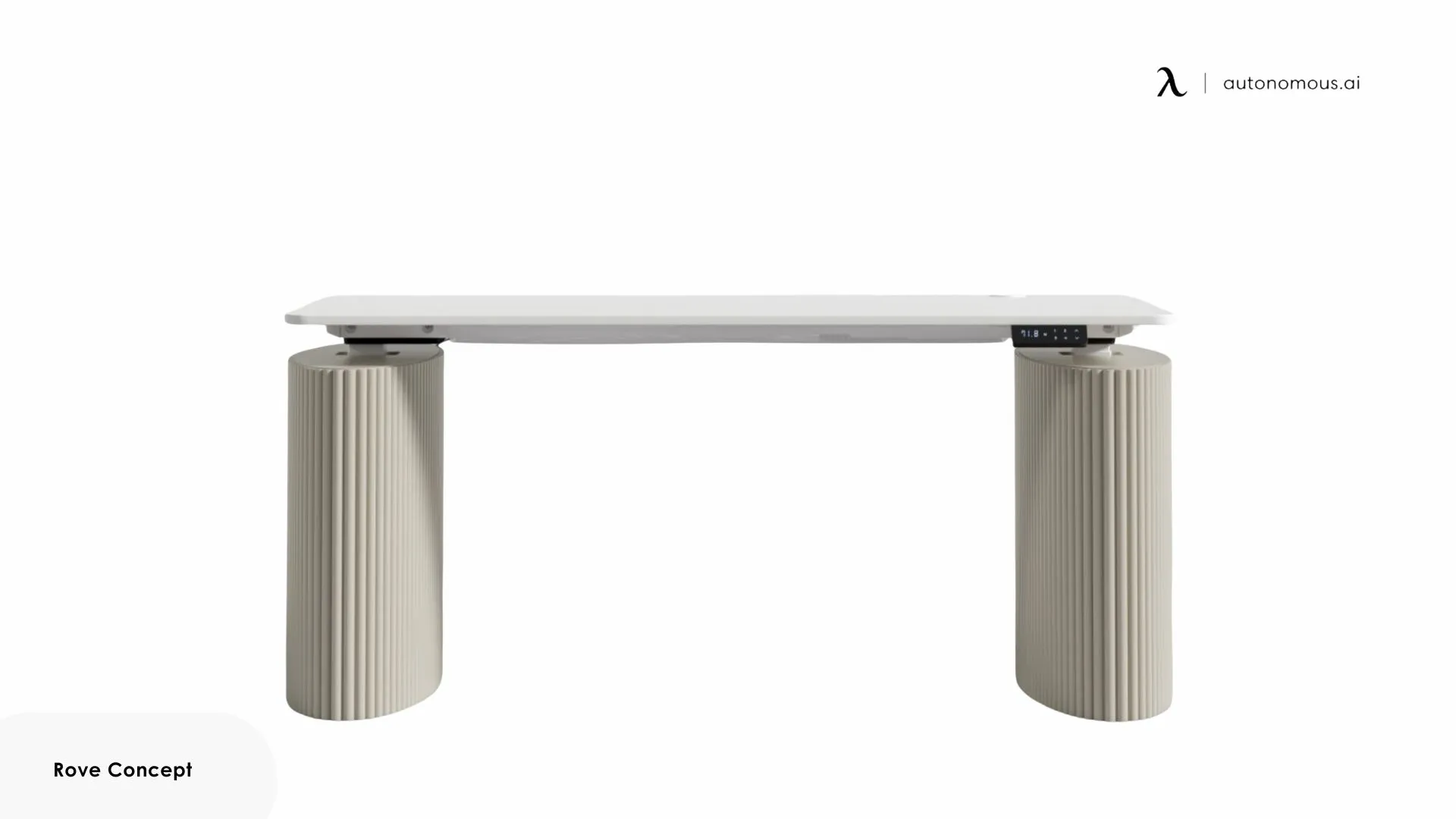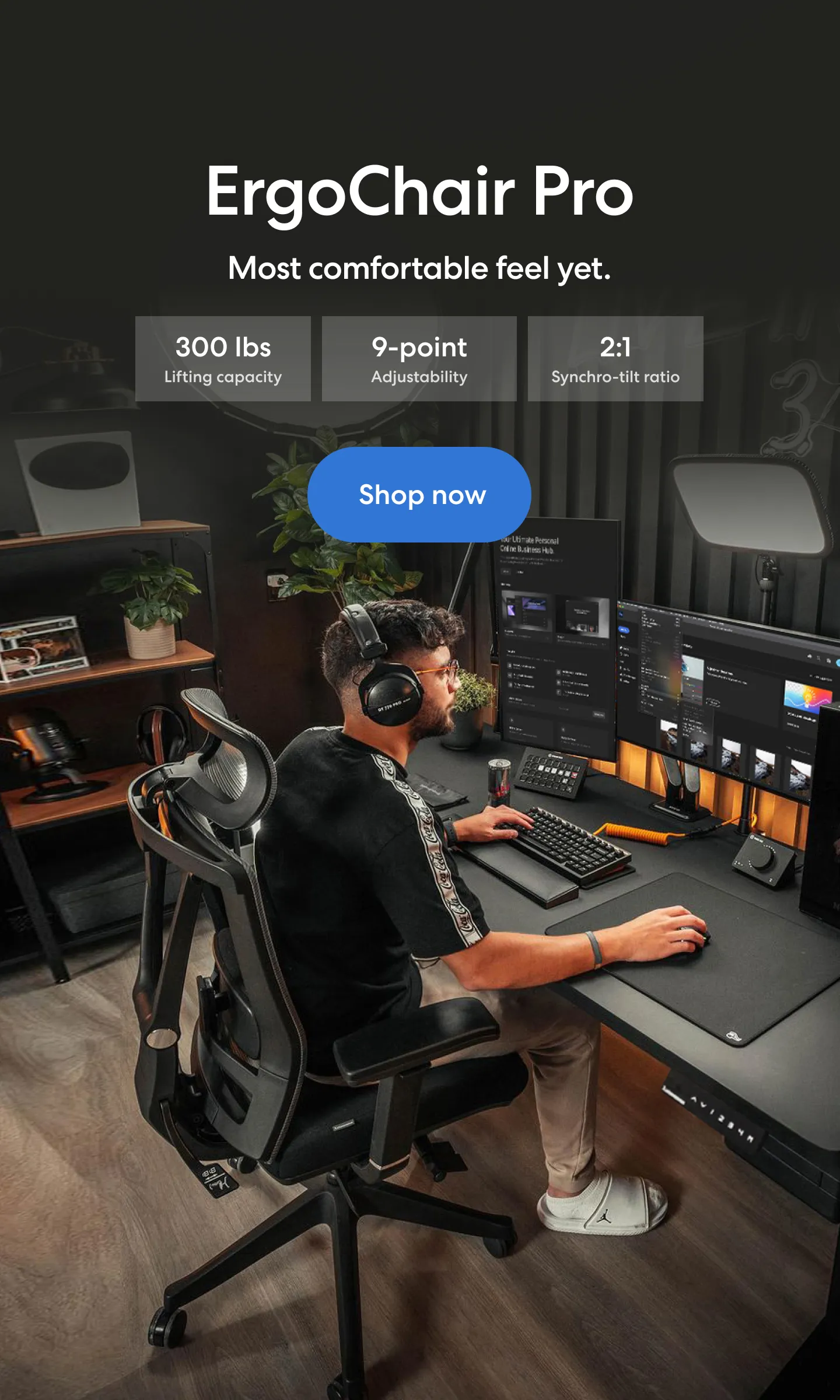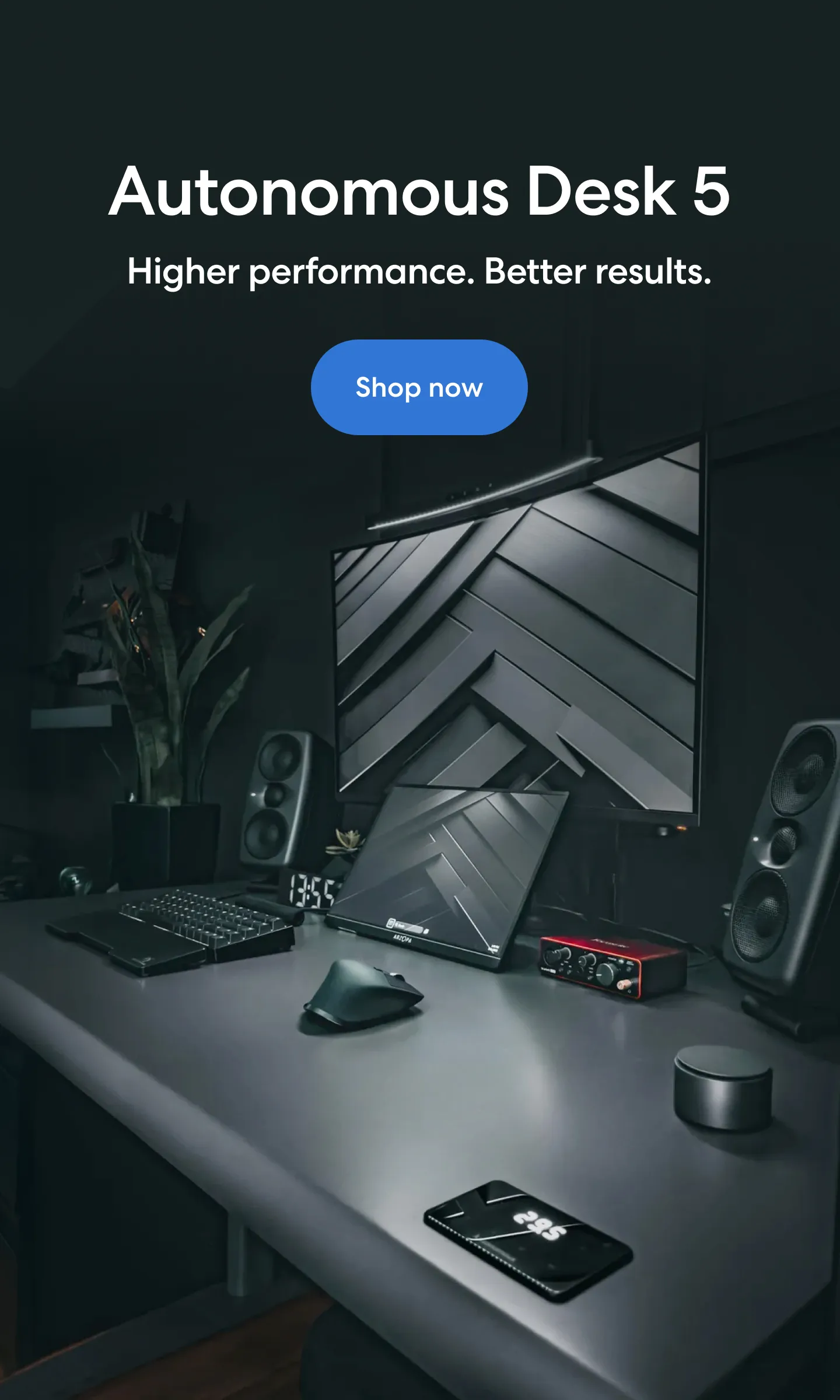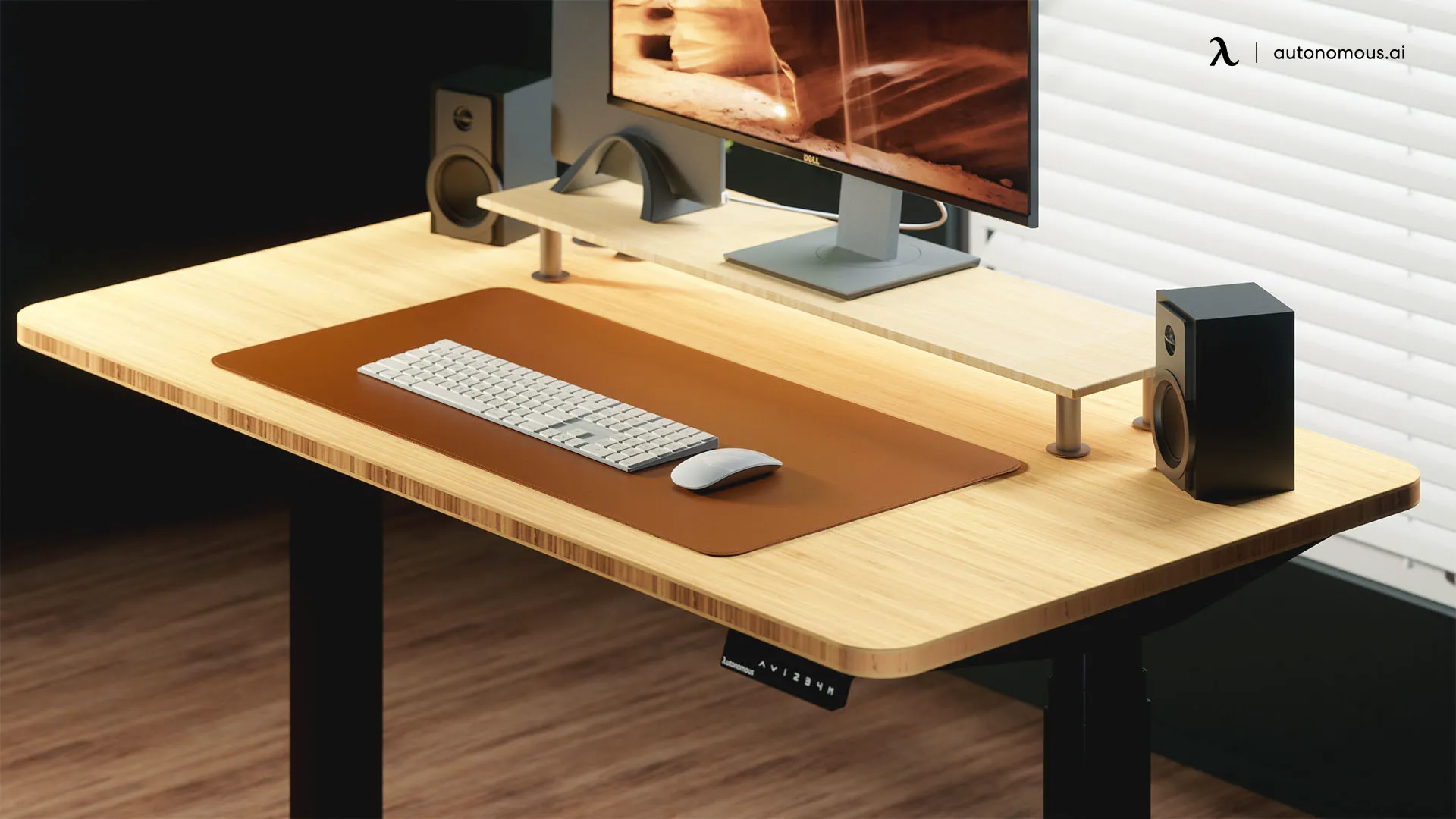
Top 10 Dark Wood Standing Desks For Modern Spaces
Table of Contents
- The Best 5 Dark Wood Standing Desks
- 1. Autonomous Desk Levitate 2
- 2. Grovemade Desk
- 3. Elephant Desk – Abundance Series
- 4. Autonomous Desk 2 (Wood Option)
- 5. Vari Electric Standing Desk
- 6. Sway Standing Desk
- 7. Keelan Scott Adjustable Standing Desk
- 8. OkayWood Standing Desk Touch
- 9. Eureka Ergonomic L-Shaped Standing Desk
- 10. Rove Concepts Eryk Standing Desk
- What’s The Best Wood For A Dark Standing Desk?
- How To Choose The Perfect Dark Wood Standing Desk
- FAQs
- Conclusion
As someone passionate about both comfort and architecture, I believe every workspace should reflect your personality while supporting how you work.
A dark wood standing desk does exactly that—bringing warmth, depth, and a sense of calm to any setup. But beyond the aesthetics, adjustable standing desks are essential for anyone spending long hours in front of a screen. They help reduce fatigue, boost focus, and encourage better posture.
In this guide, I’ve rounded up 10 beautiful, ergonomic dark wood adjustable desks that blend rich wood finishes with the functionality your home office truly deserves.
The Best 5 Dark Wood Standing Desks
With so many options out there, narrowing down the right dark wood standing desk can feel like a project in itself. If you’re leaning toward something with more warmth and character, dark wood finishes—especially walnut—offer a timeless look that balances beauty with function.
Whether you're starting fresh or enhancing your existing walnut desk setup, here are some of the most standout options that combine ergonomic benefits with the richness of real wood.
1. Autonomous Desk Levitate 2
Best for: Design-forward professionals who value clean aesthetics, quiet function, and unmatched stability.
The Autonomous Desk Levitate is more than a solid walnut standing desk—it’s a centerpiece. If you want your workspace to feel elevated without being overdesigned, this 4-leg standing desk quietly commands attention.
The dark ash wood finish brings sophistication to any room, whether you’re working from a light-filled studio or a minimalist apartment corner. Its four-leg frame not only adds symmetry but also creates an incredibly solid base that stays put, no matter how high you go.
Why it stands out:
- Non-touch electric adjustment lets you shift seamlessly between sitting and standing with a simple button press—perfect for maintaining workflow without distraction.
- The solid wood desktop (Natural Ash, dark-stained) has real texture and depth—ideal if you want something that feels grounded and authentic.
- With a 380 lb weight capacity, this desk can support ultrawide monitors, speakers, and more without compromising balance or motion.
- Integrated cable management makes it easy to keep things tidy—even in high-performance setups.
It’s a modern, architectural take on the dark wood adjustable desk, built for deep work, clean lines, and long-term satisfaction.
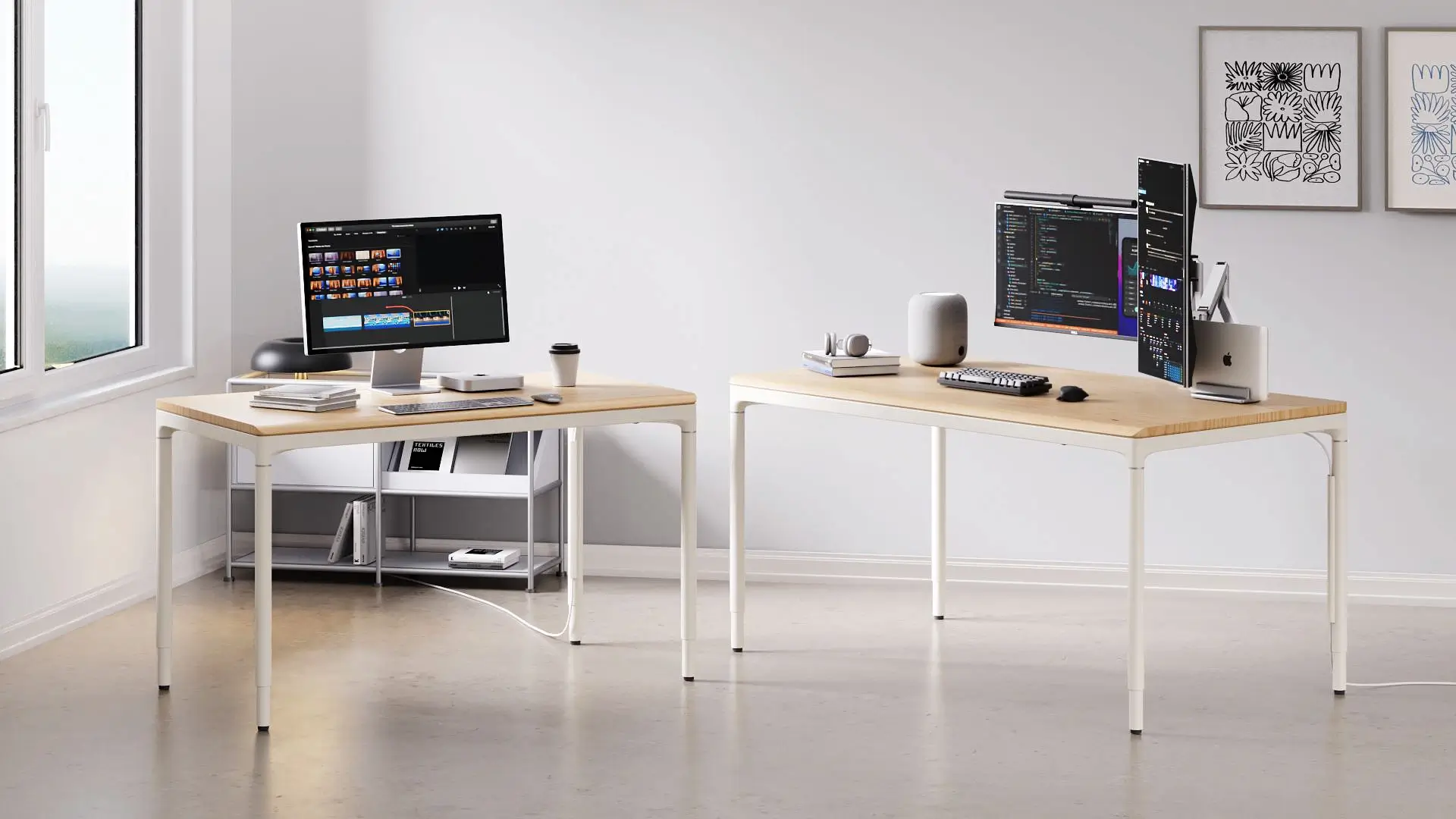
Autonomous Desk Levitate 2
| Top | Classic Top | Ultra Top |
|---|---|---|
| Dimensions | 53"L x 29"W x 1.2"H | 59"L x 31.5"W x 1.2"H |
| Shipping dimensions | 56"L x 32"W x 3"H x 53lbs | 62"L x 35"W x 3"H x 64lbs |
| Cable management | 0.4" groove on the desktop | 0.4" groove on the desktop |
| Colors | Bright Ash | Bright Ash |
| Material | Natural Solid Ash wood | Natural Solid Ash wood |
| Coating | Nitrocellulose | Nitrocellulose |
| Net Weight | 50 lbs | 55 lbs |
| Class of protection | Front IP53 |
|---|---|
| Handset | Non-touch control / One-button control |
| Handset color | Black |
| Motor type | Quad |
| Column style | Round |
| Column size | 1.4" - 1.7" |
| Load capacity | 380 lbs |
| Material | SPCC steel |
| Speed | 1.25 in/s |
| Sound level | <45 dB |
| Rated voltage | 110-250V |
| Frame size | Classic Frame: 53"L x 29"W Ultra Frame: 59"L x 31.5"W |
| Height range | 26.8" - 44.1" (without Top) |
| Surface | Power coating |
| Color | Moderate White |
| Configuration | Embedded handset |
| Anti-collision technology | Yes |
| Storage and transport temperature | 14°F - 158°F |
| Net weight | 65 lbs |
2. Grovemade Desk
Best for: Creative thinkers and detail-oriented users who view their desk as both a tool and a piece of craftsmanship.
This isn’t your typical standing desk—it’s what happens when artistry meets engineering. Grovemade’s solid walnut standing desk feels like it belongs in a design gallery just as much as it does in a home office setup.
Every element is considered, from the deep natural grain of the walnut wood to the wool-lined drawers that quietly store your essentials.
Why it stands out:
- Hand-finished solid walnut wood gives each piece a unique character—no mass-produced laminate can match the depth and richness of the natural tones.
- The desk includes brushed aluminum drawer components and Merino wool lining that elevate storage into an experience, not just a utility.
- A built-in six-outlet surge protector and braided power cord mean less cable chaos, more creative clarity.
This is a walnut standing desk with drawers that doesn’t just support your workflow—it inspires it. And if integrated storage is something you value, there are other great standing desks with drawers worth exploring that combine practicality with clean design.
3. Elephant Desk – Abundance Series
Best for: Nature lovers, remote workers, and those seeking timeless, solid-wood craftsmanship with performance to match.
The Abundance Series is what you’d get if a forest and a factory collaborated on a standing desk. It’s made from 100% South American walnut or North American ash, giving it a beautiful dark finish and solid, substantial feel under your hands. Each plank is unique, and it shows—this isn’t veneered wood pretending to be natural.
Why it stands out:
- The hard matte coating on the surface preserves the beauty of the grain while resisting scratches and moisture—perfect for daily wear and tear.
- Capable of lifting 300 lbs, this desk is ready for dual-monitor setups, audio gear, or even a desktop rig without compromise.
- The natural wood surface has a textured warmth that contrasts beautifully with tech-heavy setups, grounding your workspace visually and emotionally.
For anyone craving a dark walnut standing desk that’s as much about nature as it is about function, the Abundance Series delivers an experience—not just a surface to work on.
If you’re exploring other options in this style, take a look at our full collection of wood standing desks for more natural, ergonomic setups.
4. Autonomous Desk 2 (Wood Option)
Best for: Budget-conscious professionals who want reliable function and warm wood tones without overspending.
The Autonomous Desk 2 remains a favorite for good reason—it delivers on all the essentials. With the wood desktop option, it takes on a more refined, natural look that easily blends into both home and office spaces. If you're building out a workspace that feels personal yet practical, this minimalist desk is a solid choice.
Why it stands out:
- The dual-motor system adjusts smoothly between 27.2" to 46.5", accommodating users of all heights while staying impressively stable at full extension.
- The walnut or bamboo wood desktop brings a rich, dark tone or lighter natural option to the frame—ideal if you're aiming for a cozy, grounded aesthetic.
- The minimalist steel frame supports up to 250 lbs, making it dependable for multi-monitor setups, printers, and even desktop PCs.
For those looking to get started with a dark wood standing desk that doesn’t compromise on core features—or design— Autonomous Desk 2 remains one of the most accessible and satisfying options out there.
.jpg)
Autonomous Desk 2
| Top | Classic Top |
|---|---|
| Dimensions | 53"L x 29"W x 1"H |
| Shipping dimensions | 56"L x 33"W x 3"H x 47 lbs |
| Colors | White, Black, Walnut, White Oak, Bamboo |
| Material | Warp-proof MDF wood Natural Bamboo |
| Model | 2-Stage | 3-Stage |
|---|---|---|
| Motor type | Dual | Dual |
| Lifting speed | 1.1”/sec | 2.3”/sec |
| Lifting capacity | 250 lbs | 310 lbs |
| Noise level | 45 dB | 40 dB |
| Height range (without top) | 27.2" - 46.5" | 25.2" - 51" |
| Height range (with top) | 28.3" - 47.5" | 26.2" - 52" |
| Length range | 39.8'' - 59'' | 40" - 73" |
| Frame foot width | 23.6'' | 27.5" |
| Material | SPCC steel | SPCC steel |
| Colors | White, Black | White, Black, Grey |
| Outlet voltage | 110-240V | 110-240V |
| Anti - collision | Yes | Yes |
| Shipping dimensions | 39"L x 11"W x 9"H x 51 lbs | 43"L x 13"W x 10"H x 70 lbs |
5. Vari Electric Standing Desk
Best for: Professionals who want ergonomic upgrades, quick setup, and a sleek, low-maintenance surface.
Vari is well-known for the smart, user-friendly design, and their dark brown standing desk is no exception. If you want something that looks sharp, works well, and doesn’t take half a day to assemble, this one’s for you.
Why it stands out:
- ComfortEdge™ technology introduces a beveled front edge that reduces pressure on your arms during long typing sessions—small touch, big impact.
- The desktop uses a commercial-grade laminate that mimics real wood but resists spills, scratches, and warping—perfect if you drink coffee at your desk or share the space with others.
- Thoughtful cable management features, including a built-in notch at the rear, help keep your workspace clutter-free.
This black wood standing desk suits fast-paced environments, hybrid work setups, and anyone who wants comfort without fuss.
6. Sway Standing Desk
Best for: High-end design enthusiasts who want sustainability, beauty, and quiet strength in one seamless package.
With its hand-selected, solid walnut or dark-stained maple surface and ultra-quiet motor system, it feels more like a piece of designer furniture than a piece of office equipment.
It’s ideal if your workspace flows into your living space and you want your desk to feel intentional, not utilitarian.
Why it stands out:
- The solid hardwood surface, available in black walnut or maple stained dark, is stunning in both texture and tone. It’s hand-finished with a natural oil that enhances grain detail without adding shine.
- Made in Canada with FSC-certified wood, this desk reflects a commitment to craftsmanship and sustainability.
If you’re searching for a solid walnut standing desk that feels like it belongs in an architecture magazine, the Sway is it.
If you're interested in a desk with similar tones and character, you might want to explore other walnut standing desk options that combine rich wood aesthetics with ergonomic function.
7. Keelan Scott Adjustable Standing Desk
Best for: Users who prefer a more traditional or executive-style look with electric height adjustment.
The dark espresso-stained desktop gives it an old-school richness, while the electric height adjustment and sturdy build make it fully modern. It's perfect for lawyers, consultants, or anyone who wants a commanding setup with movement built in.
Why it stands out:
- The dark brown veneer gives it a more classic look that feels less tech-focused than most standing desks.
- Comes with dual motors and 4 memory presets, so it functions smoothly despite its more traditional style.
- Offers USB ports and cable holes built into the desktop, which is convenient for charging and routing wires.
This dark wood adjustable desk bridges traditional form with functional upgrades. And if you’re going for a refined yet uncluttered environment, it can pair well with an aesthetic minimalist desk setup that emphasizes focus, flow, and visual clarity.
8. OkayWood Standing Desk Touch
Best for: Style-savvy professionals who love tech-forward features and sustainable design.
OkayWood’s Standing Desk Touch takes a modern approach, with a slim profile and a few built-in features that aim to make daily use easier. The darker wood finishes help it feel a little warmer for a cozy desk setup than a typical office setup.
Why it stands out:
- Available in walnut and espresso-stained finishes—both neutral enough for most home setups.
- Includes an anti-collision system, which may be useful if you share the space with others or have pets.
- The desktop is scratch-resistant, making it a decent option for frequent use.
This one’s more about function than style, but it covers the basics with a few thoughtful touches.
9. Eureka Ergonomic L-Shaped Standing Desk
Best for: Multitaskers and gamers looking for an expansive dark wood workspace with advanced ergonomics.
Eureka’s L-shaped standing desk is designed for people who need more surface area without sacrificing motion. The black walnut finish wraps around your workspace, creating an immersive environment for productivity, creative work, or serious multitasking.
Why it stands out:
- The dark wood surface in black walnut finish looks rich and luxurious, but is made with a durable laminate that resists scratching and heat.
- The dual-motor lift system supports smooth and silent transitions, even with a triple monitor setup for gamers.
- Comes with built-in accessories, including a cable management tray, monitor riser, and keyboard drawer for optimized ergonomics.
If you need a dark wood standing desk that can handle complexity and still look clean, this is one of the most functional options on the market. For other options built to handle even heavier loads, you might want to explore what qualifies as the most stable sit-stand desk in today's market.
10. Rove Concepts Eryk Standing Desk
Best for: Aesthetics-first professionals who want ultra-modern form with quiet function and high-end materials.
With a deep walnut veneer top and slim, minimalist frame, this dark walnut standing desk brings an intentional, curated look to your aesthetic desk setup. If you're someone who obsesses over material palettes, this desk will make you feel right at home.
Why it stands out:
- The dark walnut veneer is rich and warm, adding personality and polish to modern interiors without going rustic.
- A touch-sensitive control panel offers height presets and is seamlessly integrated into the frame.
- The powder-coated steel legs give it a floating effect, visually light but physically stable.
For fans of sleek silhouettes and quiet luxury, this dark wood standing desk is proof that function and form don’t have to compete.
What’s The Best Wood For A Dark Standing Desk?
Choosing a dark wood adjustable desk isn’t just about color—it’s about grain, weight, maintenance, and how it fits into your overall workspace aesthetic. Some woods offer timeless richness, while others focus more on practicality or affordability.
Here’s a quick look at the best wood for a desktop:
Wood Type | Color Tones | Ideal For |
Walnut | Deep brown, rich grain | Executive desks, luxury aesthetics |
Oak (Stained) | Light-to-dark customizable | Versatility, durability |
Cherry | Reddish undertone | High-end, traditional vibes |
Maple (Stained) | Neutral to darkened | Balanced weight and strength |
Birch | Golden-to-amber tones | Budget-friendly wood desk setups |
Black laminate | Matte black finish | Minimalist, modern workspaces |
Looking for something eco-conscious? Bamboo can also be stained in darker tones and offers surprising durability with sustainability in mind.
And if you’re weighing options between real hardwood and engineered surfaces, this breakdown of MDF wood vs solid wood might help you decide what’s best for your setup in terms of price, durability, and appearance.
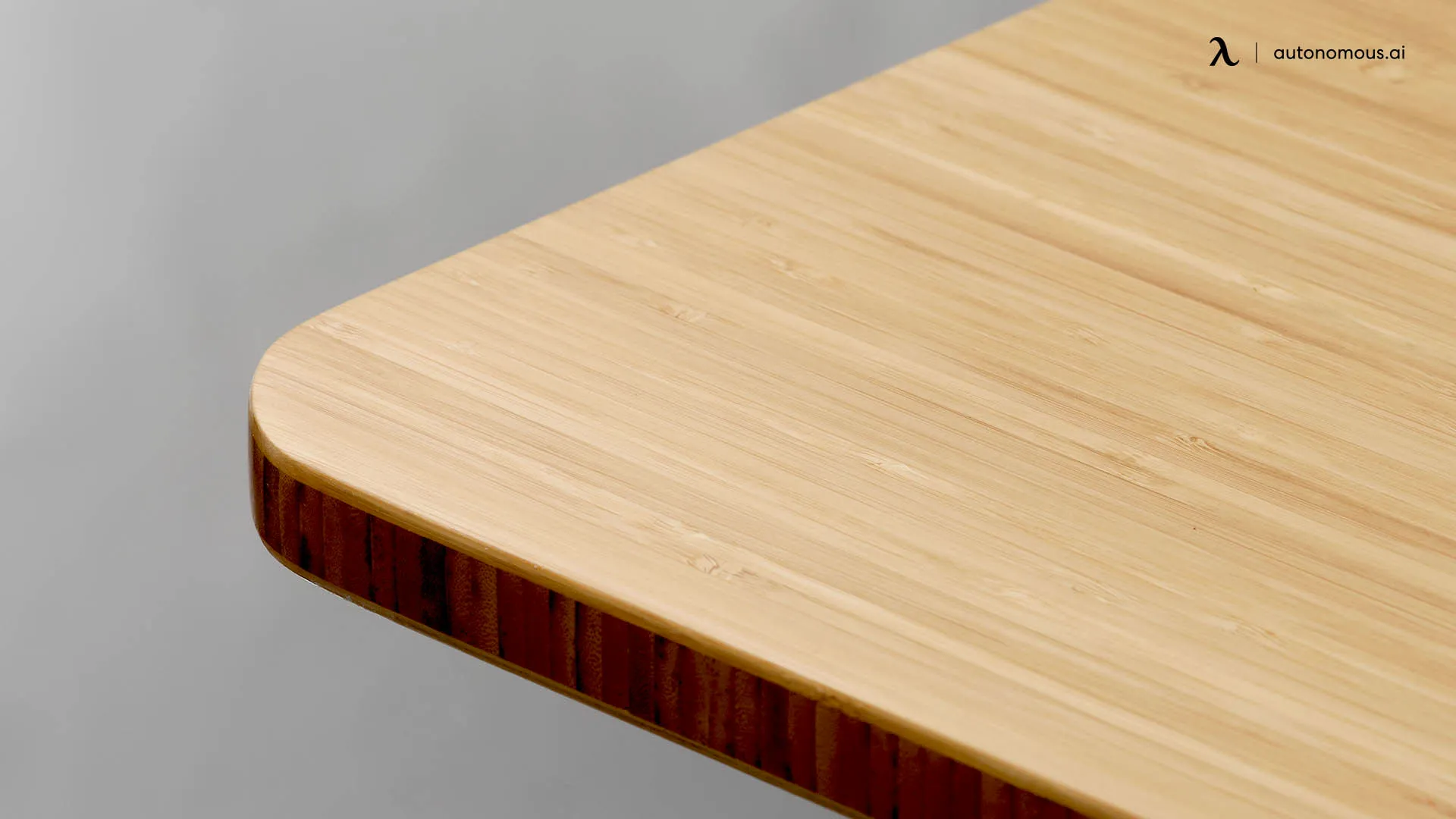
How To Choose The Perfect Dark Wood Standing Desk
Selecting the right dark wood standing desk comes down to how you work, what gear you use, and the kind of space you're creating. A few details make all the difference:
- Weight capacity:
How the black wood standing desk can handle your setup is key—especially if you're working with dual monitors, heavy audio equipment, different desk accessories, or shelving attachments. Look for a frame that stays stable at full extension.
- Desk depth matters just as much as width.
If you like spreading out with notebooks or accessories, extra surface space up front makes a big difference.
- Solid, veneer, or laminate?
Solid walnut has unmatched character but comes at a higher price. Veneer offers a similar look with less weight. Laminate options are more durable in humid environments and still carry a refined finish when done well. If you’re not sure which one suits your needs? This guide on desk materials breaks down the pros and cons of each surface and frame type.
- Storage needs:
A walnut standing desk with drawers can help keep your setup tidy, but it may limit legroom or space for under-desk accessories. It’s worth thinking through your layout before committing.
The best dark wood standing desk will be the one that fits both your space and how you work within it.

FAQs
1. What is the best dark wood standing desk for home offices?
If you’re looking for a balance between design, stability, and budget, the Autonomous Desk Levitate with a dark wood top is a standout. It blends minimalist design with a solid motor system and real ash wood, making it ideal for both compact and spacious home offices.
2. Are solid walnut standing desks worth the price?
Yes—solid walnut standing desks offer unmatched beauty and durability. The natural grain and rich brown tones elevate any space, and desks like the Grovemade model also include premium features like wool-lined drawers and built-in power.
3. What’s the difference between dark walnut and black wood standing desks?
Dark walnut desks feature natural wood grain with deep brown tones, while black wood standing desks (often laminate or stained wood) have a more uniform, matte black finish. Both are stylish, but walnut offers more warmth and organic texture.
4. Do dark wood adjustable desks scratch easily?
It depends on the finish and material. Solid woods like walnut or cherry can develop light surface marks over time, which add character. Laminate and MDF options tend to be more resistant to scratches, especially in high-use setups.
5. What are the pros and cons of a black wood standing desk?
Black wood desks offer a sleek, modern look that pairs well with minimalist setups. Pros include easy cleaning, consistent coloring, and wide availability. Cons may include less warmth than natural wood and a tendency to show dust or fingerprints more easily.
6. How do I maintain a dark brown standing desk?
Wipe the surface regularly with a microfiber cloth and avoid harsh cleaners. Use coasters to prevent water rings, and consider a desk mat to reduce wear from keyboard and mouse use. Natural wood surfaces benefit from occasional conditioning with wood-safe oils or wax.
7. Is a dark wood standing desk suitable for gaming or multi-monitor setups?
Absolutely. Many dark wood desks, especially those with dual motors and high weight capacity, are perfect for heavy setups. Just ensure the desk is wide enough for your monitors and accessories, and has built-in cable management to keep things clean.
If you're planning a full setup with a dark wood standing desk, these gaming desk setup ideas might help you design a space that’s both functional and immersive.
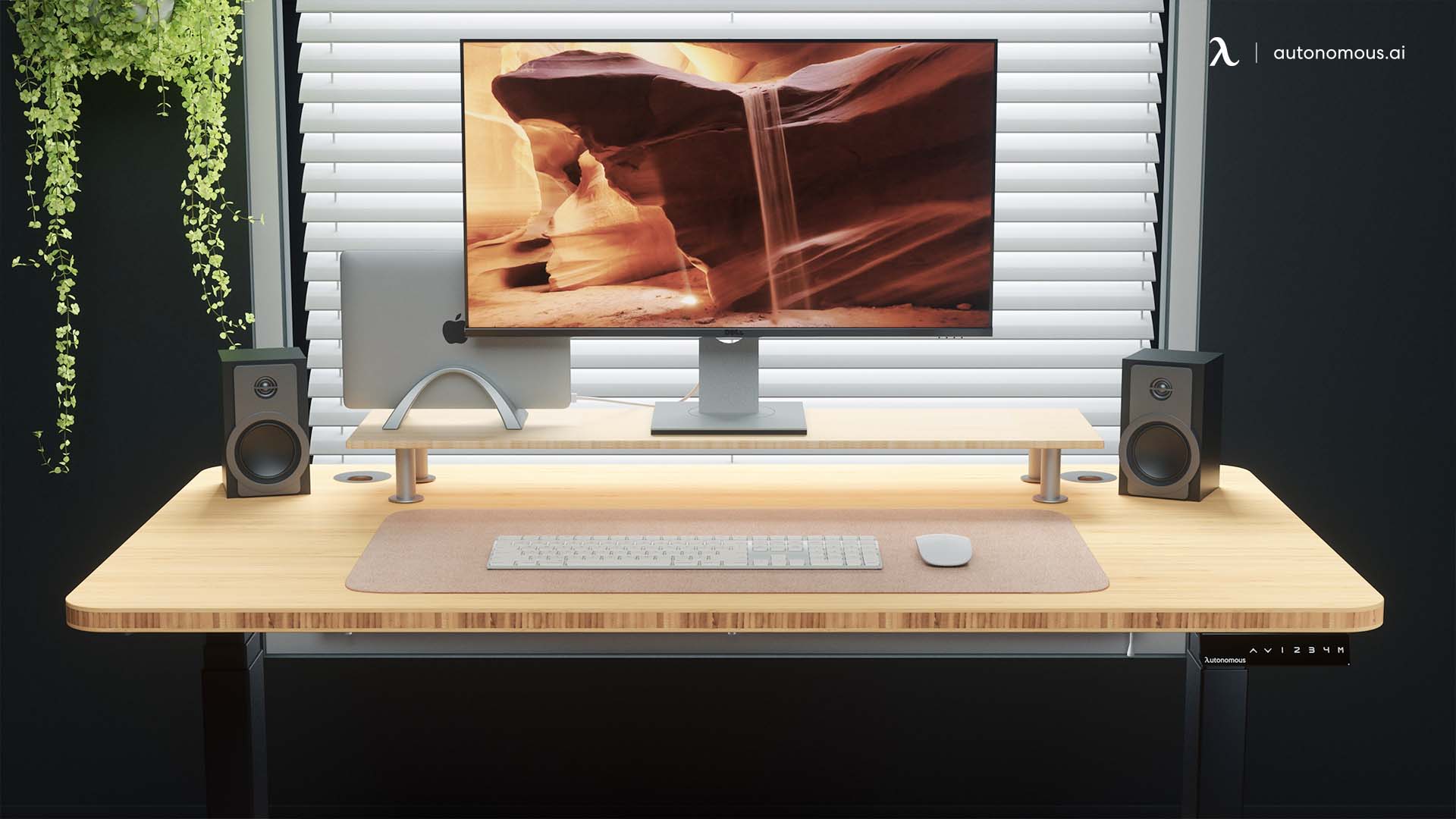
Conclusion
A dark wood standing desk does more than just support your laptop. It sets the tone for your entire workflow—stable, focused, and elevated. Whether you lean rustic, modern, or somewhere in between, these top picks offer something for every aesthetic and budget.
And trust me, once you get used to the flow of standing and sitting throughout your day—especially with a desk that’s actually beautiful—you’ll wonder how you ever worked without it.
Spread the word
.svg)



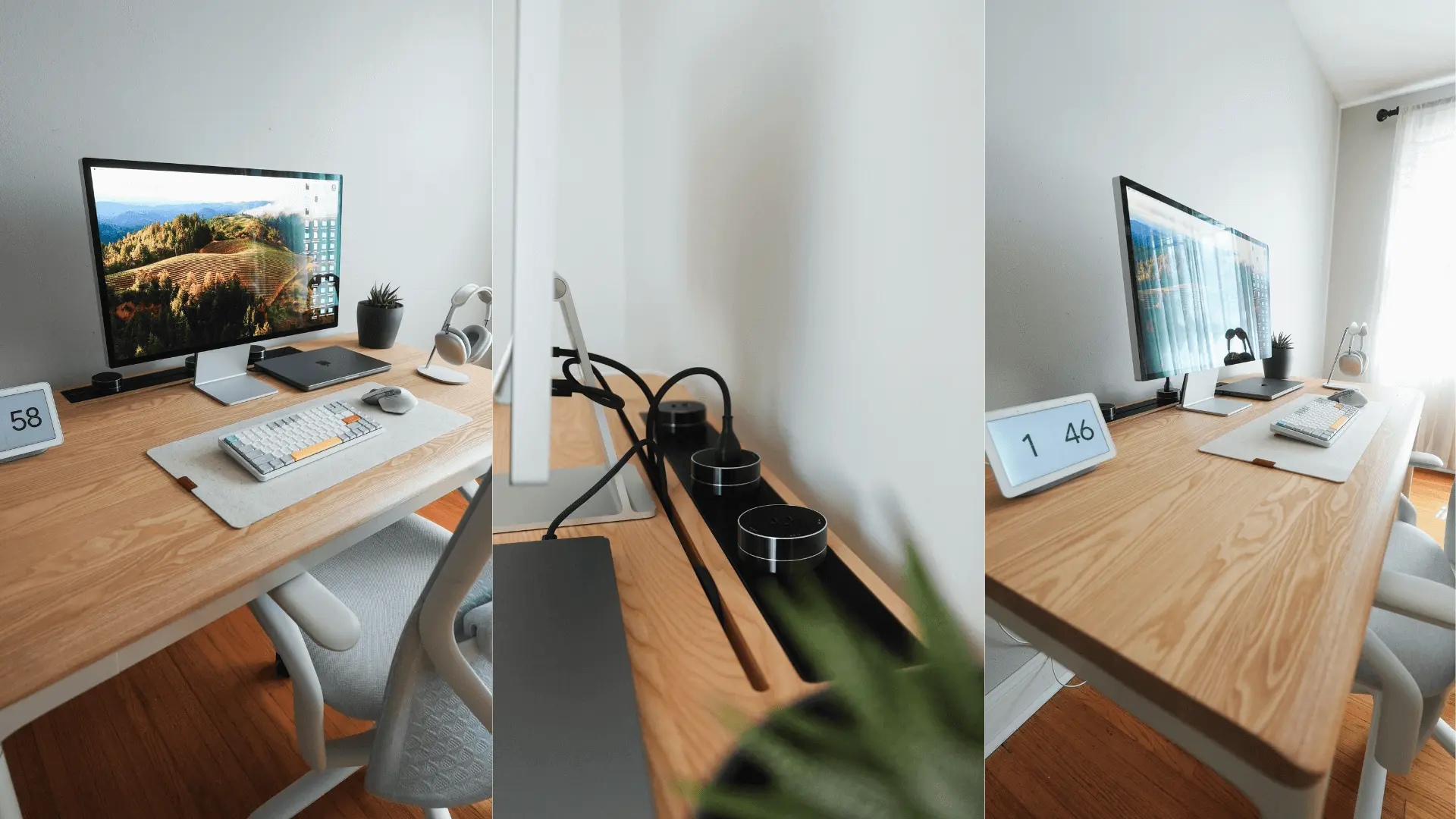
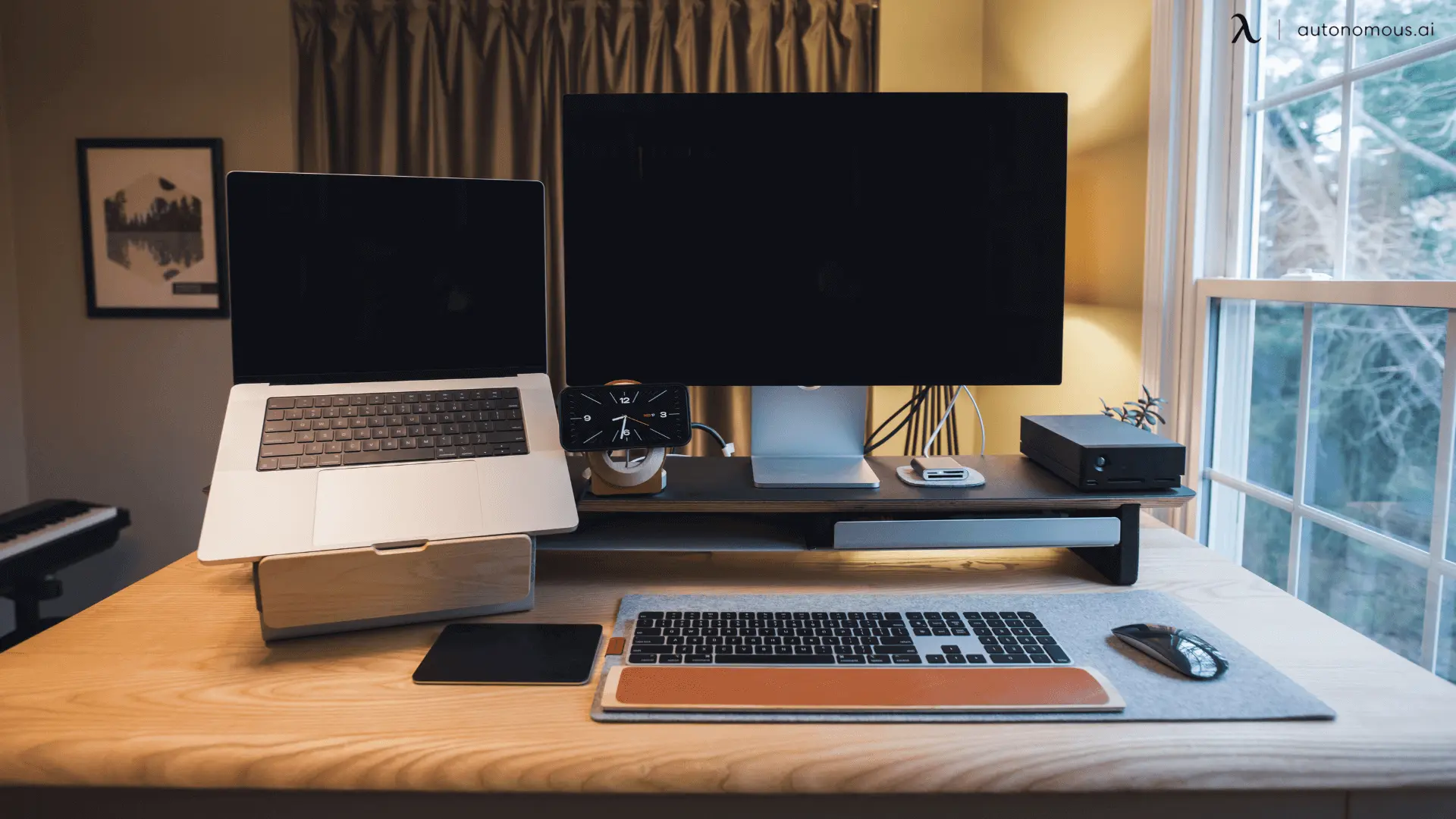
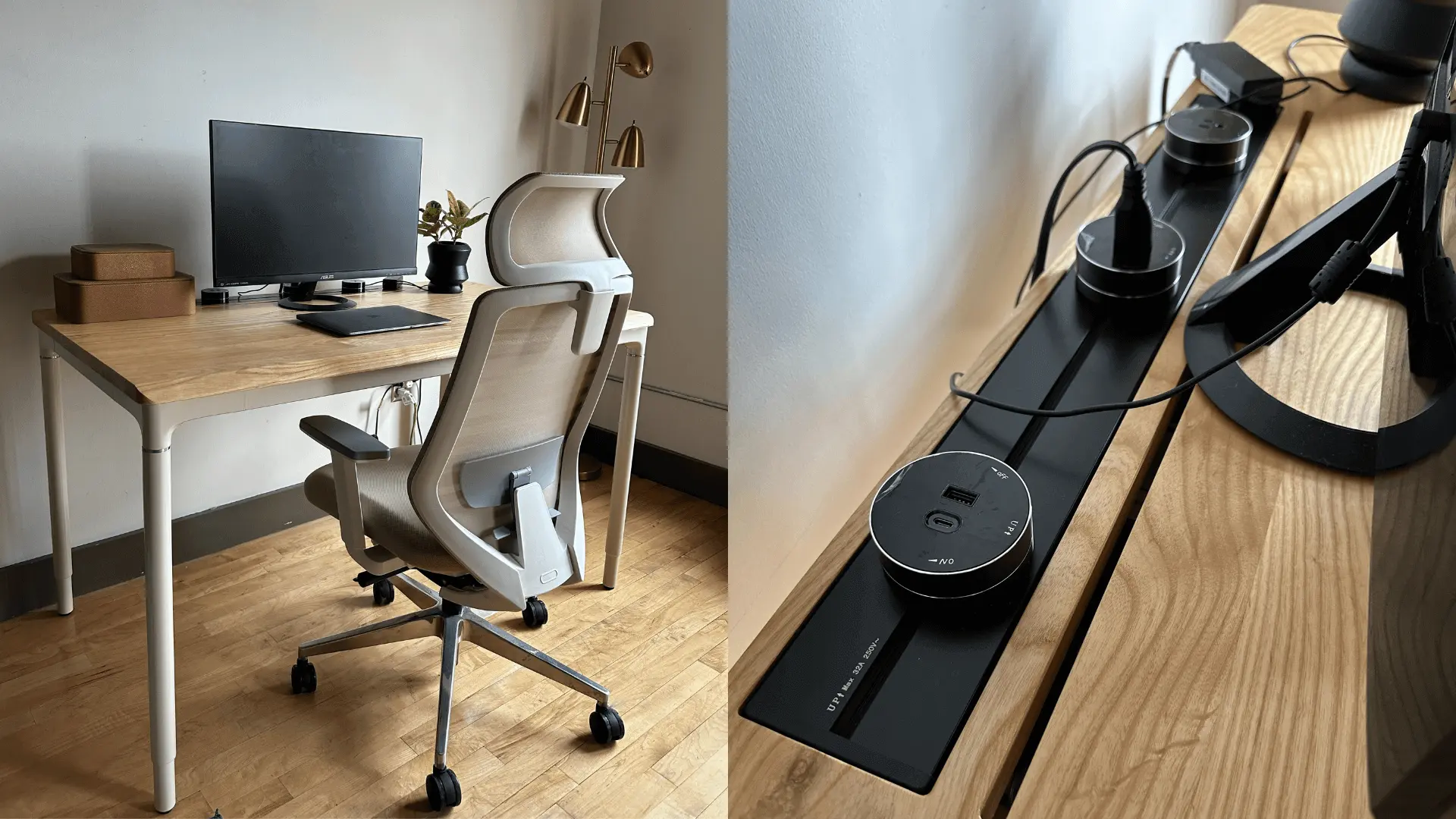
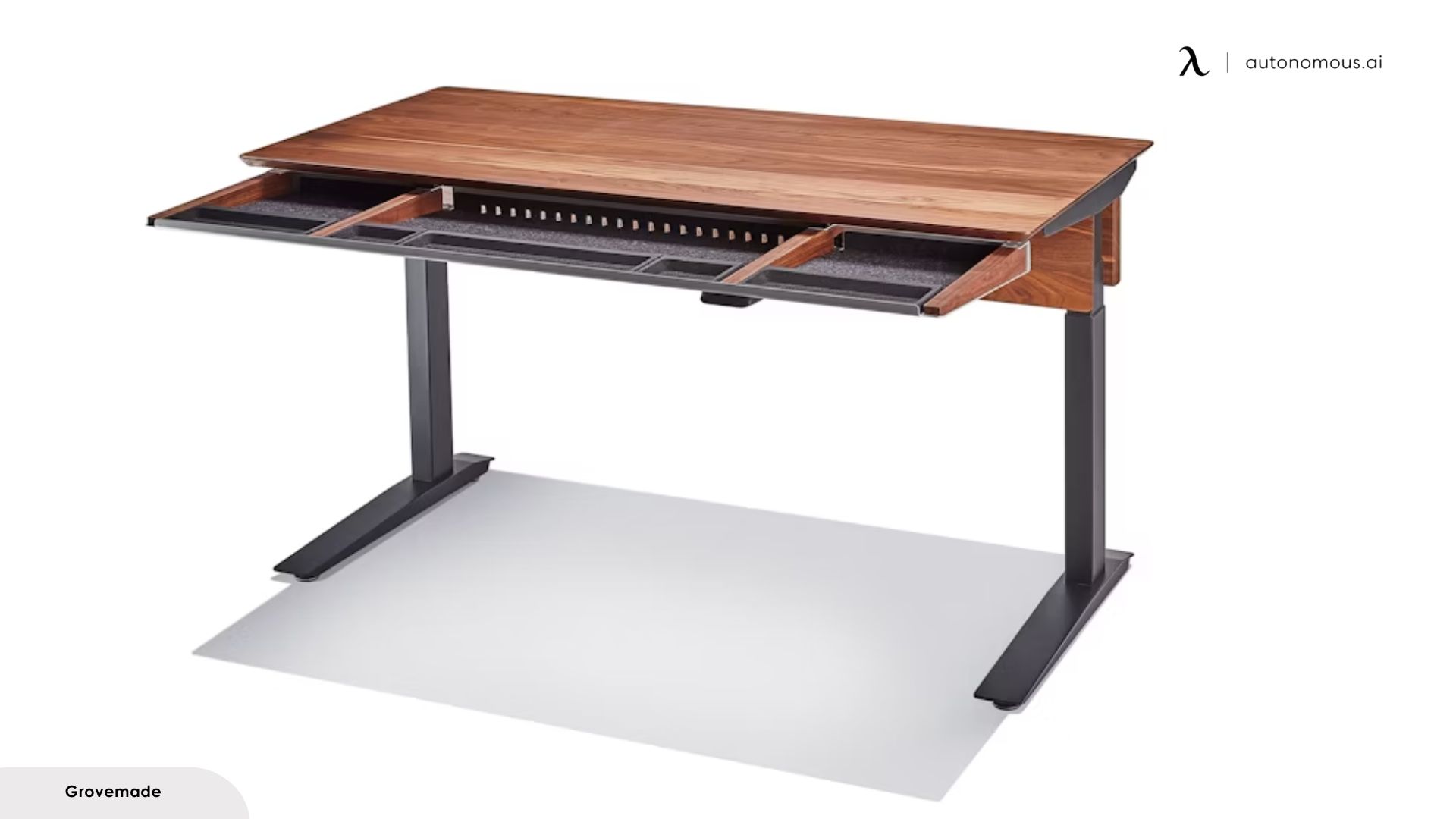
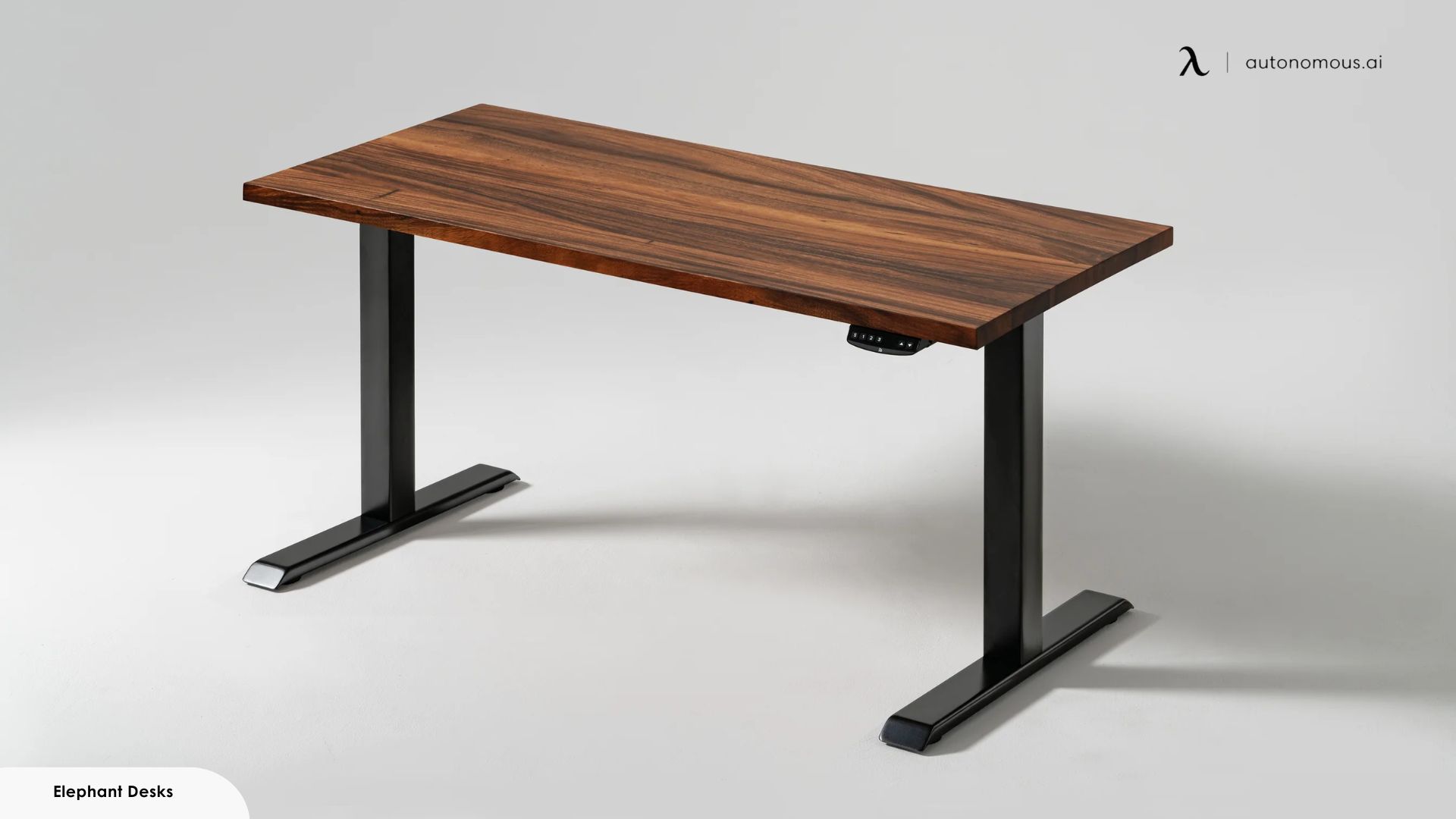
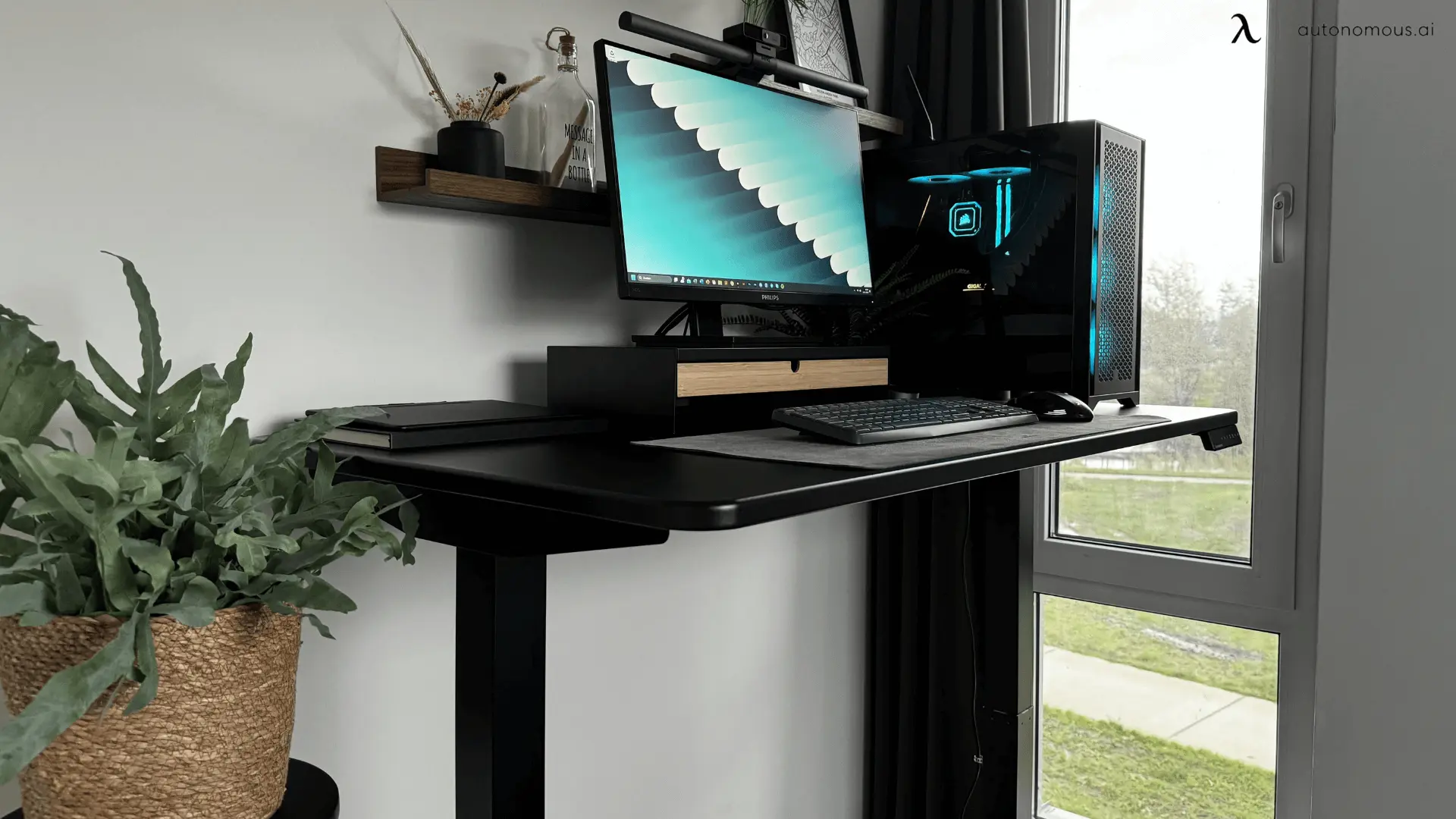
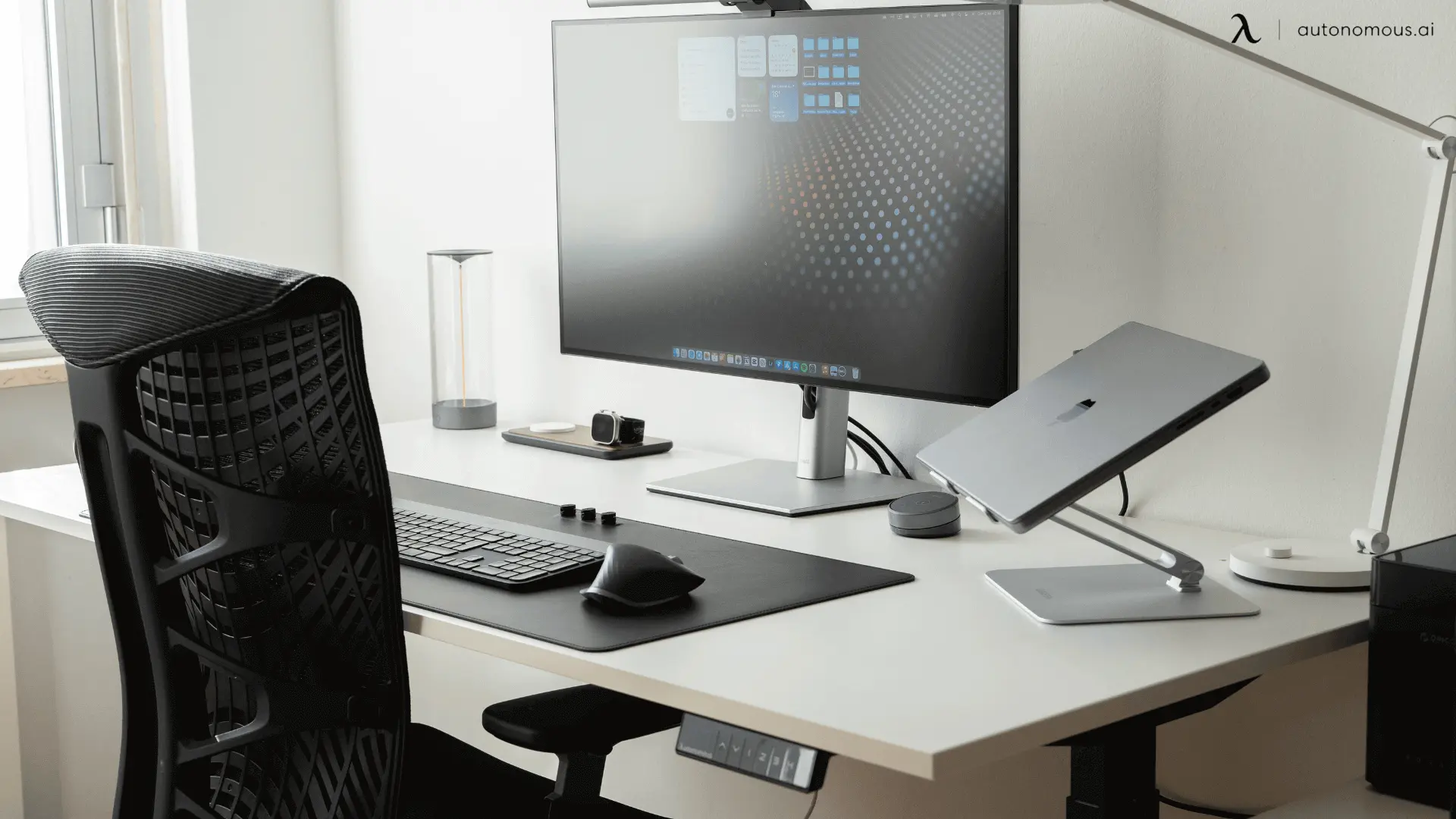
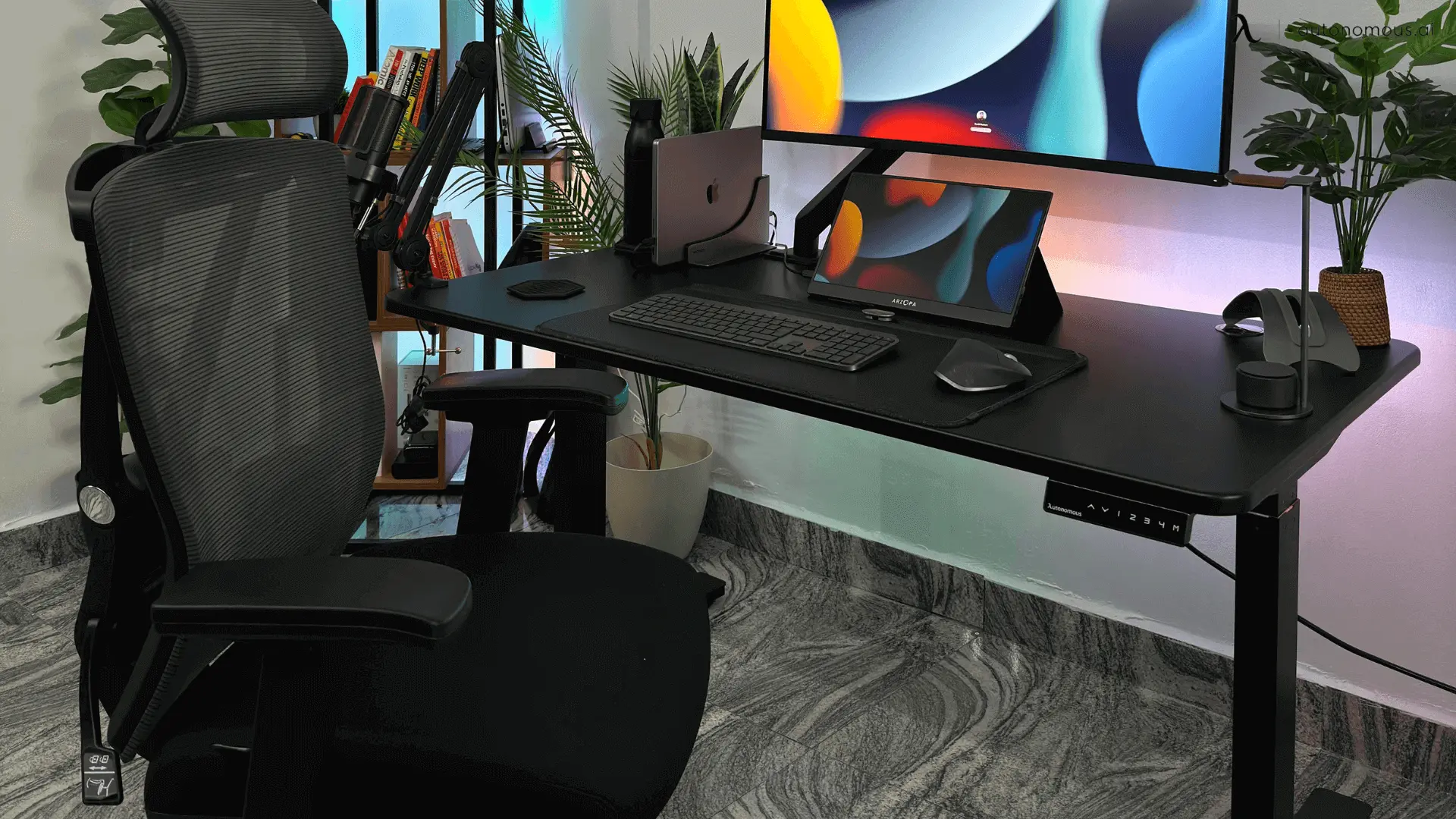
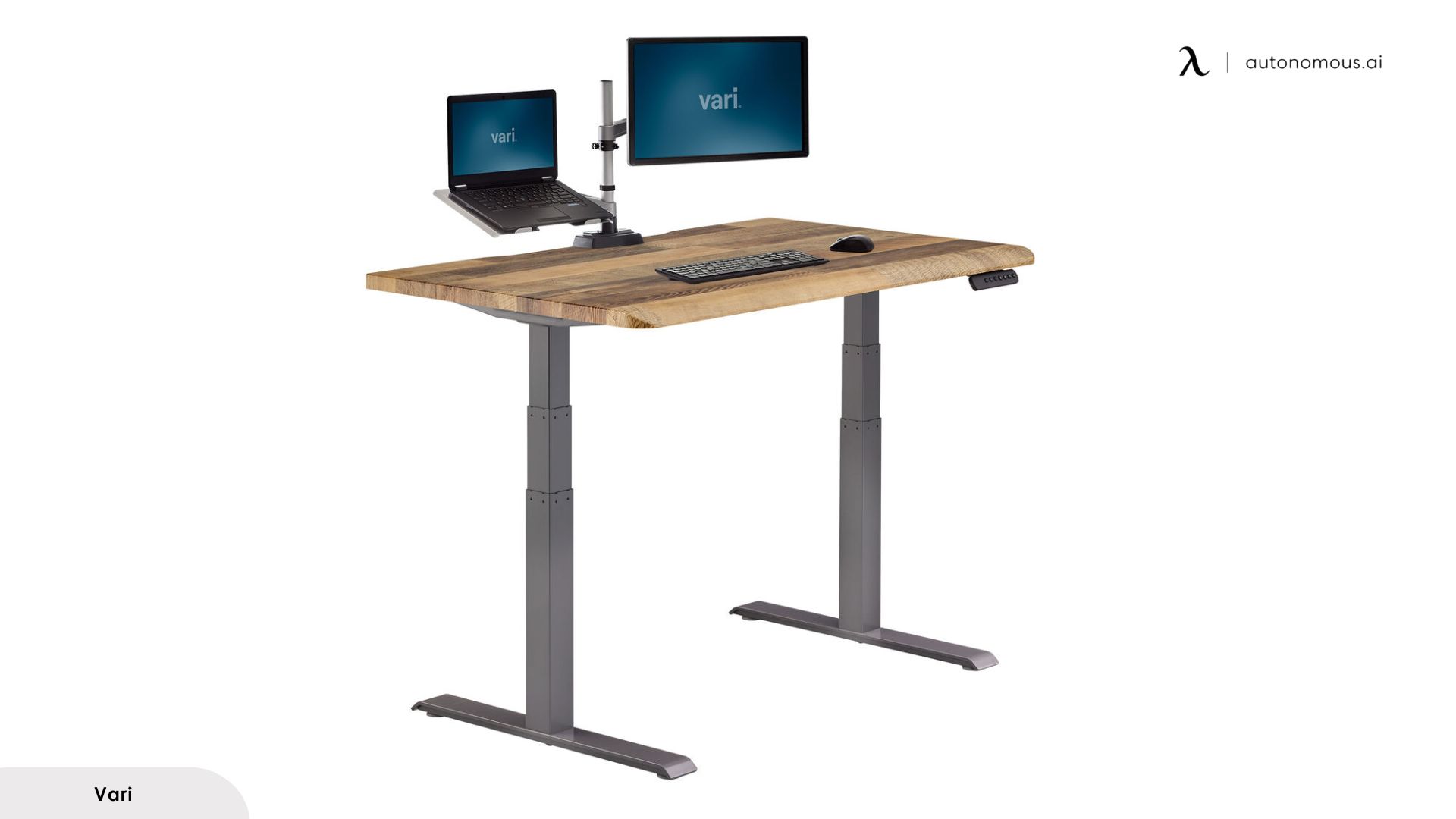
.webp)
